The Kingston HyperX Fury RGB SSD Review: Bright Idea, Dimmed Performance
by Billy Tallis on September 24, 2018 8:35 AM ESTAnandTech Storage Bench - The Destroyer
The Destroyer is an extremely long test replicating the access patterns of very IO-intensive desktop usage. A detailed breakdown can be found in this article. Like real-world usage, the drives do get the occasional break that allows for some background garbage collection and flushing caches, but those idle times are limited to 25ms so that it doesn't take all week to run the test. These AnandTech Storage Bench (ATSB) tests do not involve running the actual applications that generated the workloads, so the scores are relatively insensitive to changes in CPU performance and RAM from our new testbed, but the jump to a newer version of Windows and the newer storage drivers can have an impact.
We quantify performance on this test by reporting the drive's average data throughput, the average latency of the I/O operations, and the total energy used by the drive over the course of the test.
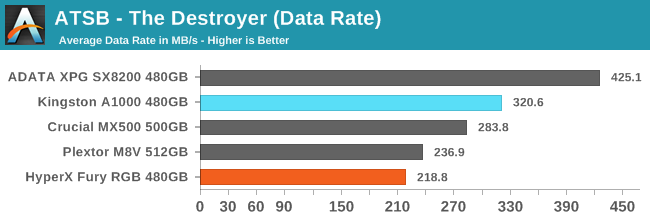
The HyperX Fury RGB's average data rate on The Destroyer is 23% slower than the Crucial MX500 and is also clearly slower than the Plextor M8V that uses the same Toshiba 64-layer 3D NAND. The Fury RGB is not delivering the performance expected from a mainstream SATA drive, let alone one with enthusiast pricing.
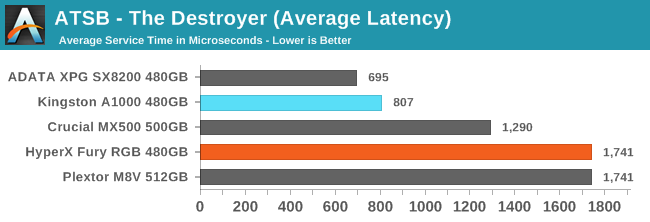
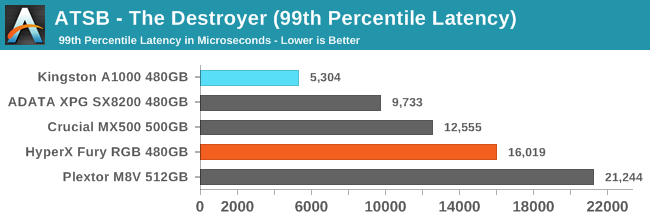
The average latency of the Fury RGB on The Destroyer is tied with the Plextor M8V and the 99th percentile latency is better, so Kingston has managed to get decent performance out of the Toshiba 3D TLC in at least some respects, but the Crucial drive is still clearly much better off.
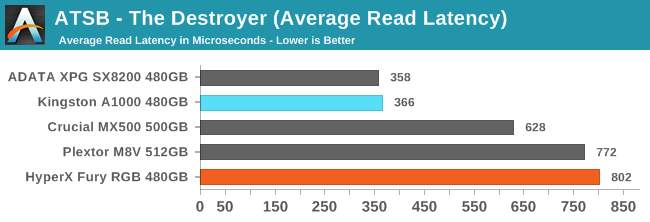

The average read latency of the Fury RGB is slightly worse than the Plextor M8V while the average write latency is slightly better, but neither drive can get the Toshiba TLC to match the performance of the Micron TLC in the Crucial MX500.
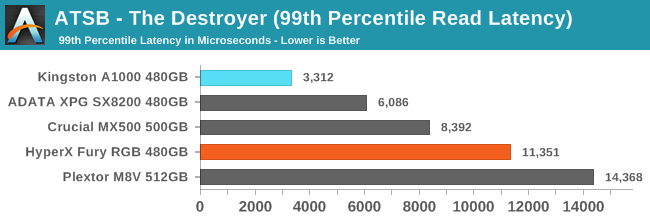

The 99th percentile read latency of the Fury RGB falls between the MX500 and the M8V and is nothing to complain about. The 99th percentile write latency surprises with a substantial advantage over the other SATA drives and even the ADATA SX8200, so Kingston's firmware for the Fury RGB is doing a good job at limiting worst-case performance stalls.
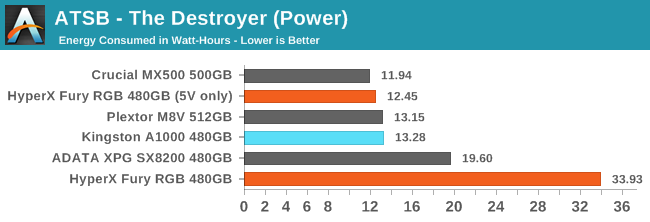
When ignoring the energy used for the LED lighting, the HyperX Fury RGB requires a similar amount of energy to complete The Destroyer as other SATA drives, despite taking a bit longer overall. The LEDs were responsible for almost 2/3 the total energy usage by the drive.










45 Comments
View All Comments
PeachNCream - Monday, September 24, 2018 - link
Form over function. All show and no go. - Those are the first things that pop into my mind after seeing the bottom drawer performance and high power consumption. We now have reached the point where there's a component that burns more electrical energy feeding pointless LEDs than it does actually fulfilling its duties as a component in a computer. Here's to enthusiasts and gamers! Good going people. You've really made the world a better place by making LEDs on everything marketable.rrinker - Monday, September 24, 2018 - link
Most make me an old fogey, but I totally agree. I'm not sure why any gamer or enthusiast would even buy this thing, do the flashing lights actually make up for the reduced performance - considering it's supposedly 'performance' these people are after. Perhaps this may be the jump the shark moment for RGB on everything - it's now gone so far that is actually affects the performance of the peripheral the lights are supposed to be 'enhancing'.melgross - Monday, September 24, 2018 - link
No, lighting is very important to a segment of that market. Lit DRAM, feet, strings of LEDs and neon inside, and out. Replacing the cover with a clear plastic one(violating the FCC protocols), is very important to them.Stupid cases such as the ones from Alienware, and others, show what these in the gaming community want. Not all of them are like that, but a big enough percentage are, and it’s a VERY big market. They get over 100,000 people to some of the ComicCons around the country.
rrinker - Monday, September 24, 2018 - link
The difference being, this one actually reduces performance. At least with most anything else up til now, it was just added cost and some increased power consumption, but the LEDs on the RAM don;t make the actual chips hotter, or the LEDs controllers on the mobo don't make the VR modules or chipset run hotter and throttle. I could probably run a lot of LEDs and still use less power than my system was when it had a GTX480, which I replaced with a GTX970. But that's just power draw, even if my system wasn't half buried in a stand under my printer next to my desk, gaudy case lighting wouldn't cause my CPU or GPU to throttle. This thing - this is just all-around fail. I guess this does not apply to the serious performance nut - the ones who swear they can tell the difference between 1MHz differences in clock speeds to the CPU or RAM, because they probably wouldn't be running SATA SSDs anyway, but this is just beyond insane, reducing performance and increasing cost for the sake of a bunch of flashing lights. I have a bridge to sell the people that go for this, too. Oh wait, I better add lots of LED lights to it first.melgross - Monday, September 24, 2018 - link
RAM runs hot as it is. Adding LEDs doesn’t help. Does it damage performance? I don’t know.qlum - Tuesday, September 25, 2018 - link
DDR4 doesn't run that hot and adding leds on the edge of the memory sticks doesn't impact the temperature of the ram much. Heat from the top of the sticks is pretty easy to dissipate. Besides that this sdd uses way too much leds and blocks most of their light.dromoxen - Tuesday, September 25, 2018 - link
The telling point is that you can use this without the data storage functionality (and excess cables) getting in the way of its true purpose, which is to light the way to the Promised LandTitanX - Tuesday, September 25, 2018 - link
indeed..i want not a single light on my PC except for the HDD activity and power indicator. no glass..no view panels..just an inconspicuous black box.MrSpadge - Monday, September 24, 2018 - link
At least the naming is adequate: it makes you hyper furious while waiting for your data and wondering about your electricity bill!TitanX - Tuesday, September 25, 2018 - link
dude..its 2 watts...dont think that makes more than a nickel a year on the ole bill..